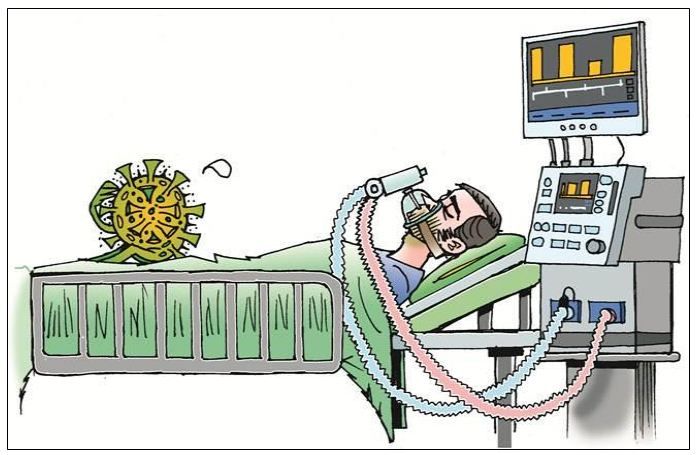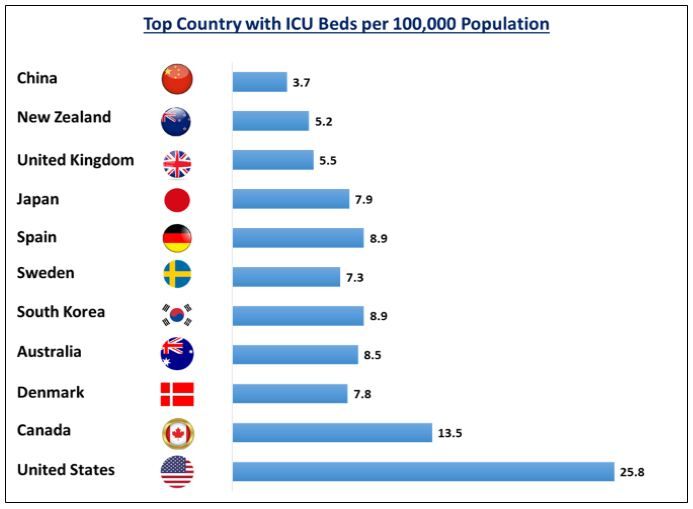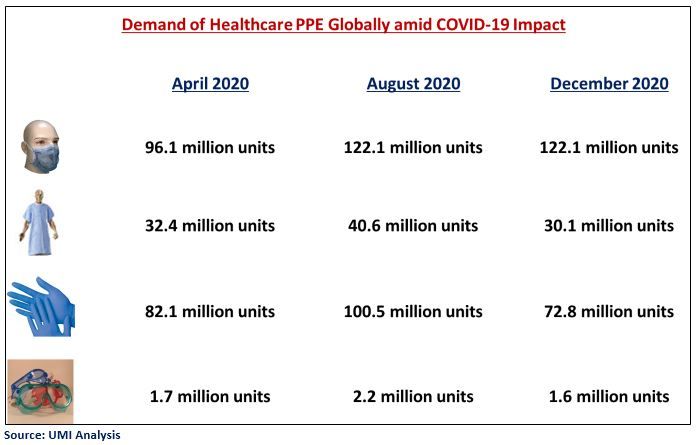
Countries Rushing For More Ventilators And Ppe Kits Amid Covid-19 Outbreak
Shortage of Ventilators as critical patient require ventilators to survive
As per the report published by UnivDatos Market Insights titled “Global Ventilator Demand Analysis-COVID-19 Impact (Feb-Dec 2020)”, ventilator demand owing to covid-19 impact is expected to witness very high growth by dec 2020, the United States to witness the highest demand. In severe cases, the coronavirus causes serious damage to the lungs, causing the patient’s body to lose oxygen levels making and it harder to breathe. A ventilator is used to relieve the patient by pushing air with increased levels of oxygen into the lungs and its humidifier matches the air supply’s heat and moisture with the patient’s body temperature. Before the COVID-19 outbreak, it was estimated that 77,000 new ventilators were enough to meet the market demand globally, however, new studies suggest that this demand has surged dramatically to a hefty 880,000 more ventilators after COVID-19 pandemic. It is also estimated that, of the total COVID-19 cases occurring globally, about 10% of patients need ventilators.

Steps taken by countries globally to meet the demand
United Kingdom: In the UK, the estimated number of ventilators NHS has is 5,000 adult and 900 children’s ventilators, and there’s a gap of 30,000 ventilators to cope with the surge in COVID-19 patients. To meet this demand, the UK government has asked manufacturers from industries such as automotive and aerospace to produce the ventilators. It has also issued specifications to companies such as Jaguar and Airbus for the acceptable rapidly manufactured ventilators
United States:The US currently has approximately 172,000 ventilators, many of which are already used by patients suffering from other issues and it is estimated that 960,000 coronavirus patients may require to be put on ventilators. Hence, FDA has issued permission to auto manufacturers such as Ford, General Motors and Tesla to produce ventilators.
India:According to a report, India’s state hospitals have approximately 14,220 ventilators of which 6000 have been specially dedicated to coronavirus patients. It is also noted that India only manufactures 10% of the total ventilators used in the country and as the pandemic has disrupted the supply chains globally, India needed to increase the production capacity of ventilators domestically. Many PSUs (state-owned enterprises) and private players have stepped up to contribute to manufacturing ventilators. Bharat Electronics Ltd. (BEL) has committed to 30,000 ventilators and HLL Lifecare has taken out a tender for 20,000 ventilators. Companies like Tata, Skanray Technologies, Mahindra & Mahindra, Maruti Suzuki India are also focussing on a scaled-up production of ventilators
Demand for PPE amidst COVID-19 Outbreak
Personal Protective Equipment (PPE) includes protective gear for eyes, face, ears, clothing, respiratory protection, protective footwear, hand protection, etc. PPE is required across various industries such as medical, construction, manufacturing, Oil & gas, chemicals, pharmaceuticals, food, etc. As per the report published by UnivDatos Market Insights titled “Global Healthcare PPE Demand Analysis-COVID-19 Impact (Feb-Dec 2020)”, global healthcare PPE demand amid covid-19 impact, is expected to reach 265.4 million units by august 2020, the US to witness the highest demand through the COVID-19 Outbreak.

Shortage of PPE putting health workers at risk:The global supply chains of personal protective equipment get disrupted, caused by increasing demand, hoarding, panic purchases, and misuse amidst Coronavirus outbreak. The shortage of PPE is putting health workers and other frontline workers at risk due to limited access to masks, gloves, goggles, face shields, gowns, etc. WHO estimated that 89 million masks, 76 million gloves, and 1.6 million goggles will be required each month for COVID-19 response.
Costs of protective equipment are skyrocketing:As the coronavirus pandemic continues to spread, the costs of protective equipment are skyrocketing due to a surge in demand. PPE are mostly disposable items and as the coronavirus spreads the demand is still outpacing the supply, causing prices to increase exponentially. Although manufacturers globally increased their production, however, they are also facing shortages of specific raw materials to manufacture protective equipment as many countries have imposed lockdown and export bans and thus disrupting the whole supply and logistics.
Global production shifts towards manufacturing protective equipment and medical devices
Many countries have been implementing measures to help industries expand their production capacities to produce PPE and other medical essentials. China took various measures to support the production of medical gear by providing aid in procuring raw materials, hiring workers, and offering tax breaks to the manufacturers. It has also asked automobile manufacturers to produce masks and other types of PPE
Initial Projects Approved for Medical equipment demand fulfilment amid COVID-19 Outbreak
Africa: US$ 82 million will help Ethiopia address critical needs for COVID-19 preparedness and response, including the provision of vital medical equipment, health system capacity-building, and support to establish treatment centers. In the Democratic Republic of Congo, US$ 47 million will provide immediate support to put in place containment strategies, train medical staff and provide equipment to ensure rapid case detection and contact tracing.
East Asia and the Pacific: In Mongolia, US$ 26.9 million will help provide training for emergency care doctors, nurses, and paramedics; purchase medical and laboratory equipment and supplies; rehabilitate health care facilities; and strengthen the country’s capacity to respond to health crises. In Cambodia, US$ 20 million will help establish laboratories and isolation and treatment centers in 25 provincial referral hospitals and equip them with essential medical and testing supplies
Europe and Central Asia: In Tajikistan, US$ 11.3 million will help expand intensive care capacity through equipment, supplies, and training, as well as supporting coordination with the public. The most vulnerable households will also be protected through temporary social assistance. In the Kyrgyz Republic, US$ 12.15 million will help boost the capacity of rapid-response teams, hospitals and laboratories by providing medical and laboratory supplies, ICU equipment, and preparedness funds for hospitals
Latin America and the Caribbean: Haiti, the region’s poorest country, will benefit from a US$ 20 million IDA grant with immediate support to minimize COVID-19 transmission through more testing for early detection and rapid response teams to help contain outbreaks. The financing will also mobilize additional health staff and provide equipment to improve patient care. In Ecuador, US$ 20 million will help finance medical supplies for COVID-19 cases and equip a greater number of intensive care units and isolation rooms. Support will also help finance the national communication strategy and dissemination of prevention and protection messages in the short and medium-term
The Middle East and North Africa: A US$ 26.9 million IDA grant will be implemented in partnership with the WHO to help Yemen limit the spread and mitigate risks associated with COVID-19. The World Bank is also supporting the implementation of Djibouti’s Preparedness Plan with US$ 5 million in IDA credit. Support will focus on immediate needs and response to the pandemic while helping strengthen health systems across the country
South Asia: US$ 100 million will support Afghanistan to slow and limit the spread of COVID-19 through enhanced detection, surveillance, and laboratory systems, as well as strengthen essential health care delivery and intensive care. In India, US$ 1 billion emergency financing will support better screening, contact tracing, and laboratory diagnostics; procure personal protective equipment; and set up new isolation wards. US$ 200 million will support Pakistan’s preparedness and emergency response in the health sector and include social protection and education measures to help the poor and vulnerable cope with the immediate impacts of the pandemic
